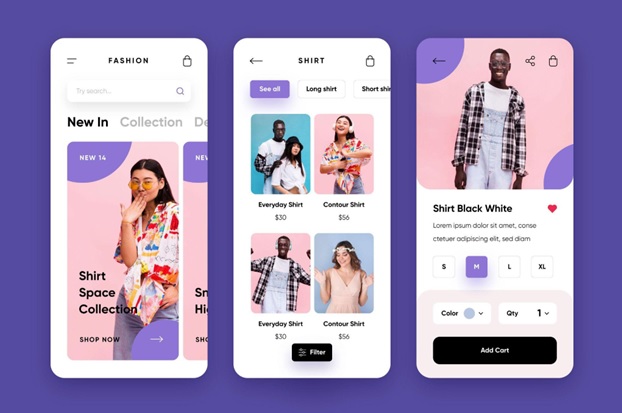According to recent reports, global e-commerce sales are projected to reach $7.5 trillion by 2025, highlighting the industry’s immense potential.
The e-commerce landscape continues to grow at a rapid pace, driven by technological advancements. To stay relevant and competitive, businesses need to adopt exclusive e-commerce app development trends.
These trends help improve user experience and drive higher conversion rates.
Here is an in-depth look at the top e-commerce app development trends shaping the future of online retail.
1. AI-Powered Personalization
Unlike traditional static interfaces, AI algorithms continuously learn from user interactions, helping them improve their recommendations with every session. E-commerce apps can predict what products customers are likely to buy next by analyzing browsing patterns, wishlists, cart behavior, and past purchases.
Key Technologies Enabling AI Personalization:
- Machine Learning (ML): ML models specify patterns in user data to suggest personalized products.
- Natural Language Processing (NLP): NLP encourages chatbots and voice assistants to comprehend and respond to user queries conversationally.
- Predictive Analytics: Assists in demand forecasting and personalized marketing campaigns by precisely predicting user intent.
Advanced Use Cases:
- Personalized homepage content tailored to individual preferences.
- Dynamic pricing based on user demand and purchasing history.
- AI-driven email marketing with customized offers.
Real-World Success Story: Amazon’s AI recommendation engine is a benchmark in personalization. It generates up to 35% of the company’s total sales by showing users products they are most likely to buy.
2. Voice Commerce Integration
The convenience of shopping using voice commands appeals to a wide range of users. It especially captivates those seeking quick and hands-free solutions.
Core Features of Voice Commerce:
- Voice Search Optimization: Ensures that product listings are optimized for voice queries.
- Voice-Assisted Navigation: Users can browse product categories or check order status seamlessly by using voice commands.
- Voice Payments: Seamless integration with digital wallets and payment gateways helps users to complete transactions securely using voice verification.
Industries Benefiting the Most:
- Grocery: Quick reordering of essentials.
- Electronics: Browsing specifications and reviews hands-free.
- Fashion: Searching for specific items utilizing voice descriptions.
Trend Insight: With 75% of households predicted to have smart speakers by 2025, optimizing apps for voice commerce is becoming important.
3. Augmented Reality (AR) for Virtual Try-On
AR technology bridges the gap between digital and physical shopping experiences by allowing users to visualize products in their environment or on themselves.
Key AR Features in E-commerce Apps:
- Virtual Try-On: Helps users try clothing, accessories, and even makeup virtually.
- Spatial Visualization: Allows customers to see how furniture or home decor items would look in their actual living space.
- AR Product Guides: Provides interactive product demonstrations and shows users how to use or assemble a product.
Technological Enablers:
- AR SDKs (Software Development Kits): Apple’s ARKit and Google’s ARCore help simplify the integration of AR into apps.
- 3D Modeling: High-quality 3D models enrich the realism of virtual try-ons and product views.
Business Impact: AR improves customer confidence and reduces return rates by reducing the uncertainty in online shopping. Brands like IKEA and Sephora have reported higher engagement and lower returns since integrating AR features.
4. Progressive Web Apps (PWAs)
Progressive Web Apps (PWAs) are web applications that provide a seamless app-like experience to users. They combine the best of both worlds and offer the convenience of a mobile app. The best part is that there is no need to download from app stores.
Key Characteristics of PWAs:
- Offline Functionality: PWAs can work offline or with poor internet connectivity by caching essential data.
- App-Like Feel: Provides smooth navigation and fast load times, similar to native apps.
- Push Notifications: Keeps users engaged by sending timely updates about orders and new products.
Trend Adoption: Flipkart’s PWA, Flipkart Lite, led to a 70% increase in conversions and tripled users’ time spent on the site. Similarly, AliExpress saw a 104% increase in new users across all browsers after launching its PWA.
5. Subscription-Based Models
Subscription models have emerged as a key trend in e-commerce. They provide predictable revenue streams for businesses while offering convenience and savings for customers. Users can subscribe to receive regular deliveries of their favorite products without the hassle of repeated ordering.
Popular Types of Subscription Models:
- Curated Subscriptions: Propose personalized selections based on user preferences, such as monthly beauty boxes or book clubs.
- Replenishment Subscriptions: Promises timely delivery of essential items like groceries, pet food, or personal care products.
- Access-Based Subscriptions: Provides exclusive access to premium content or services, such as fashion rentals or fitness apps.
Benefits for Businesses:
- Higher Customer Retention: Subscription models nurture long-term relationships with customers by increasing lifetime value (LTV).
- Recurring Revenue: Provides a steady cash flow and improves financial stability.
Success Story: Birchbox is a pioneer in beauty subscriptions, and it capitalized on this trend by offering personalized monthly boxes. This approach boosted customer engagement and also provided valuable data for product recommendations and inventory planning.
6. One-Click Checkout and Digital Wallet Integration
Studies indicate that nearly 70% of online shoppers abandon their carts before completing a purchase. To combat this, businesses are adopting one-click checkout and digital wallet integration, two key innovations designed to streamline the buying process.
What is One-Click Checkout?
One-click checkout streamlines the process by permitting users to complete their purchase with a single tap or click. This takes place without repeatedly entering payment and shipping details. This technology stores the user’s information securely after their first purchase and makes future transactions faster and frictionless.
Benefits of One-Click Checkout:
- Speed and Convenience: Decreases the number of steps in the checkout process and enriches the all-around user experience.
- Higher Conversion Rates: Businesses can enormously reduce cart abandonment. They can execute this by minimizing the effort required to complete a purchase.
- Improved Mobile Shopping Experience: Since mobile users often struggle with lengthy forms, one-click checkout presents a seamless solution for mobile e-commerce.
Digital Wallet Integration
Digital wallets help customers store payment information by making transactions faster and more secure. E-commerce apps cater to a broader audience by integrating popular digital wallets and providing multiple payment options that enhance convenience.
Popular Digital Wallets:
1. Global Wallets:
- Google Pay
- Apple Pay
- PayPal
- Amazon Pay
2. Region-Specific Wallets:
- Paytm (India)
- Alipay (China)
- M-Pesa (Africa)
3. Cryptocurrency Wallets: E-commerce apps are beginning to accept payments in Bitcoin and Ethereum as cryptocurrencies gain popularity. Integrating crypto wallets presents a unique payment option for tech-savvy consumers.
Why It Matters:
- Improved Security: Digital wallets employ encryption and tokenization, which reduces the risk of fraud and data breaches.
- Faster Transactions: With pre-stored payment information, digital wallets cut the need for manual entry. It also helps speed up the checkout process.
- Cross-Border Payments: Digital wallets simplify international transactions by proposing multi-currency support.
Impact of One-Click Checkout and Digital Wallet Integration
- Increased Repeat Purchases: A seamless checkout experience facilitates customers to come back for future purchases.
- Better Customer Satisfaction: Businesses are enhancing user satisfaction by offering fast and diverse payment options.
7. Social Commerce Integration
Social commerce is changing the way people shop online. It is fading the lines between social media engagement and e-commerce. Instead of directing users to external websites, social commerce helps customers discover, browse, and purchase products directly within social media platforms.
Core Features of Social Commerce Integration
- In-App Shopping: Platforms like Instagram, Facebook, TikTok, and Pinterest have in-app shopping experiences. It enables users to complete purchases without leaving the app.
- Social Sharing: E-commerce apps incorporated with social platforms allow users to share product reviews. They help share recommendations and wishlist items with their network. It assists in driving organic traffic and word-of-mouth marketing.
- Influencer Marketing: E-commerce apps enable influencers to link directly to products, which makes it easier for followers to purchase items promoted by their favorite creators.
Examples of Social Commerce Success
- Instagram’s Shop Feature: Instagram’s “Shop Now” feature authorizes users to explore product collections and make purchases directly from a brand’s profile or an influencer’s post.
- TikTok’s Shopping Integration: TikTok’s integration with Shopify encourages merchants to create shoppable ads and link them directly to their store. The platform’s viral nature intensifies product visibility and leads to instant sales spikes.
8. Blockchain for Transparency and Security
Blockchain technology is gaining momentum in e-commerce. It operates on a decentralized ledger, where data is encrypted and immutable.
Key Applications of Blockchain in E-commerce
- Secure Payments: Blockchain’s encrypted transactions decrease the risk of payment fraud. Some e-commerce apps are adopting blockchain-based payment systems for faster and low-cost international transactions.
- Transparent Supply Chains: Blockchain enables end-to-end traceability of products. It helps businesses verify the origin and authenticity of goods.
- Loyalty Programs: Token-based loyalty programs built on blockchain allow users to earn, store, and redeem points securely across multiple platforms.
Emerging Trends:
Brands like Everledger use blockchain to authenticate diamonds and luxury items. This helps ensure buyers receive genuine products with verified origins.
9. Green Commerce and Sustainability Features
Sustainability has become a notable differentiator in e-commerce. These days, consumers are prioritizing eco-friendly products and brands. To meet this demand, e-commerce apps are adopting green commerce initiatives aimed at reducing their environmental impact.

Sustainability Features in E-commerce Apps
- Sustainable Packaging Options: Apps authorize users to choose eco-friendly packaging at checkout, reducing plastic waste.
- Carbon-Neutral Delivery: Some apps partner with logistics providers, offering carbon-neutral shipping by offsetting emissions.
Why It’s Important:
- Consumer Demand: A study revealed that 88% of consumers prefer brands with sustainable practices.
- Brand Reputation: Adopting green initiatives enriches brand image and builds trust.
- Long-Term Loyalty: Eco-conscious consumers are more likely to remain loyal to brands that align with their values.
Example:
The fashion brand Patagonia is a leader in green commerce. It offers repair services, promotes second-hand sales, and uses recycled materials in its products.
10. Improved Data Analytics and Insights
Data is indeed the backbone of e-commerce success. Advanced data analytics tools embedded in e-commerce apps support businesses to gain deep insights into customer behavior. These tools optimize pricing strategies and level up marketing efforts.
Key Trends in Data Analytics
- Predictive Analytics: Helps businesses anticipate future demand and manage inventory efficiently. They also offer personalized recommendations based on predictive models.
- Sentiment Analysis: E-commerce apps can gauge user sentiment toward products and services, helping improve offerings by analyzing customer reviews and feedback.
- Real-Time Analytics: Real-time tracking of key metrics like Customer Lifetime Value (CLV), Average Order Value (AOV), and Conversion Rates. These metrics help businesses to make data-driven decisions on the fly.
Benefits of Advanced Analytics:
- Improved Customer Experience: Personalized recommendations and timely presents enhance user satisfaction.
- Higher Profit Margins: Data-driven pricing strategies and demand forecasting optimize revenue.
- Better Marketing ROI: Analytics helps target the right audience with the right message and also supports improving campaign effectiveness.
Final Thoughts
The e-commerce industry is more dynamic than ever, with new trends continually reshaping how businesses connect with their customers. Staying ahead of these trends is vital for companies aiming to thrive in a highly competitive market.
Thus, whether through AI-driven personalization, AR-enhanced shopping experiences, or blockchain-based security, the latest advancements in e-commerce app development promise a future of seamless, secure, and personalized online shopping experiences. The bottom line here is that businesses that invest in these trends can only level up customer satisfaction and boost profitability in the long run.







